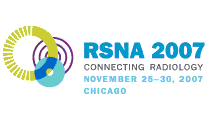
Abstract Archives of the RSNA, 2007
Jennifer Linn MD, Presenter: Nothing to Disclose
Friederike Schwarz, Abstract Co-Author: Nothing to Disclose
Hartmut Brückmann, Abstract Co-Author: Nothing to Disclose
Indra Yousry MD, Abstract Co-Author: Nothing to Disclose
The cavernous sinus (CS) contains the internal carotid artery (ICA), oculomotor nerve (CNIII), trochlear nerve (CNIV), ophthalmic nerve (CNV1), maxillary nerve (CNV2), and abducens nerve (CNVI). Detailed MR Imaging (MRI) of the CS is essential for evaluation of the different pathologies involving the CS. Thus, we aimed to determine the value of 3 Tesla (3T) MRI in the visualization of the anatomy of the CS using a gadolinium (Gd)-enhanced 3D-FIESTA (fast imaging employing steady state acquisition) sequence.
15 patients without pathologies in the CS were included. MRI was performed on a 3T scanner (Signa, General Electrics) using a Gd-enhanced 3D-FIESTA sequence. Images were analyzed collaboratively by two readers on a standard workstation and the ratings were arrived at by consensus. It was recorded if CNIII, CNIV, CNV1, CNV2, CNVI, the medial and lateral walls of the cavernous sinus could be identified. The nerves diameter and the distances between the individual nerves and the ICA were determined. Measurements were performed for each side separately.
The cranial nerves could be identified in the following percentages: CNIII in 100% (both sides), CNIV in 60 % (right side), and 70% (left side), CNV1 in 70% (right side), and 20% (left side), CNV2 in 70% (right side), and 60% (left side), and CNVI in 100% (right side), and 80% (left side). The mean distances were 2.5 and 2.6 mm (between CNIII and CNIV), 7.3 and 6.7 mm (between CNIII and CNVI), 6 and 7.1 mm (between CNIII and CNV1), and 1.5 and 1.8 mm (between CNIII and ICA), on the right and left side, respectively. The mean diameter of the nerves were determined as 1.4 mm for CNIII and 0.6 mm for CNIV (both sides), 1 and 0.9 mm for CNV1, 0.9 and 0.8 mm for CNV2, and 0.9 and 0.8 mm for CNVI (right and left side, respectively).
The contrast-enhanced 3D-FIESTA sequence performed on a 3T scanner is an adequate tool for analyzing the complex anatomy of the CS and its contents and allows the determination of the cranial nerves diameters and spatial relationships.
High field MR imaging can help in the formulation of differential diagnosis of pathologies involving the CS and should be performed for presurgical planning.
Linn, J,
Schwarz, F,
Brückmann, H,
Yousry, I,
High-resolution Imaging of the Detailed Anatomy of the Cavernous Sinus at 3Tesla. Radiological Society of North America 2007 Scientific Assembly and Annual Meeting, November 25 - November 30, 2007 ,Chicago IL.
http://archive.rsna.org/2007/5010291.html

